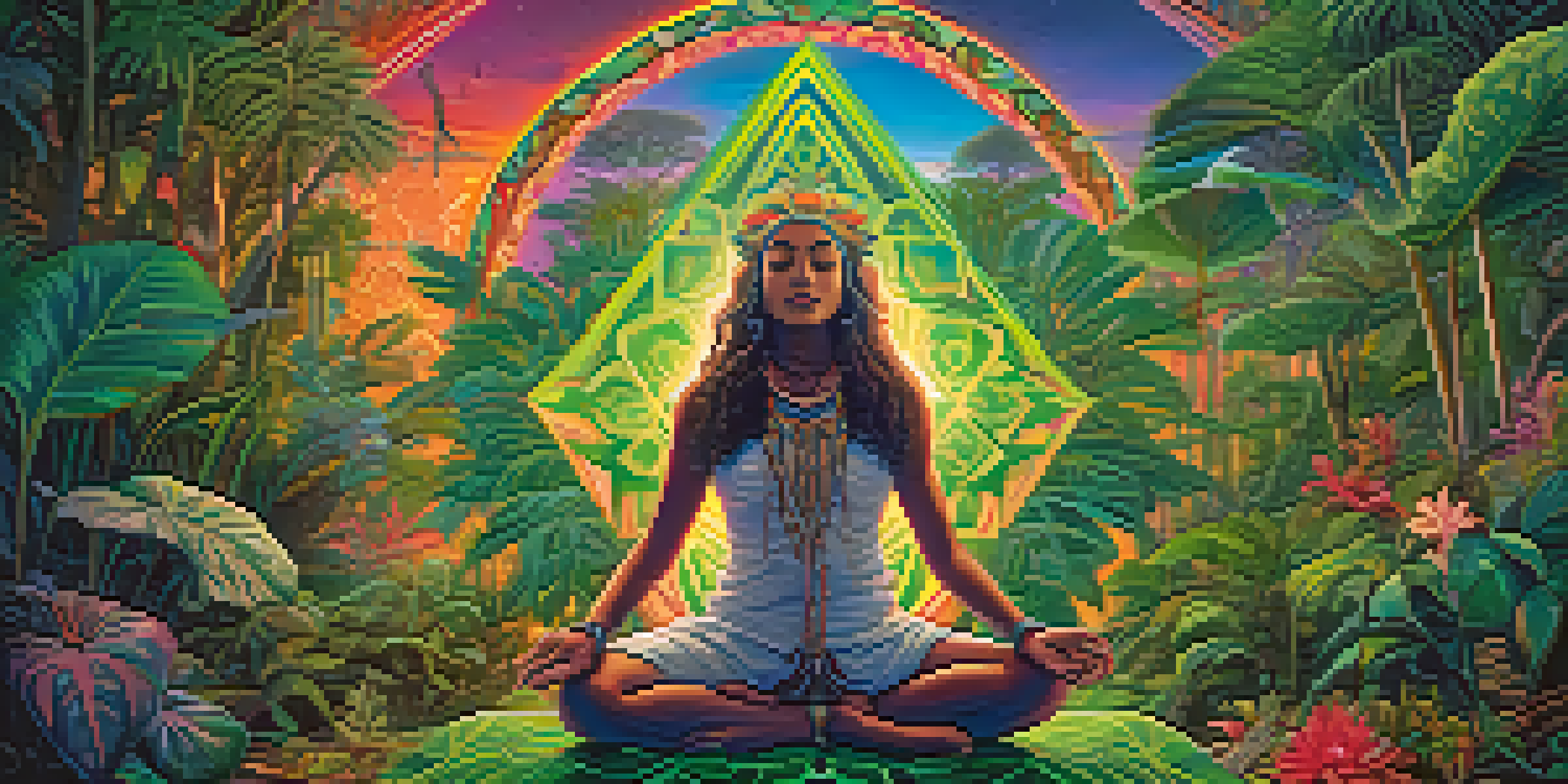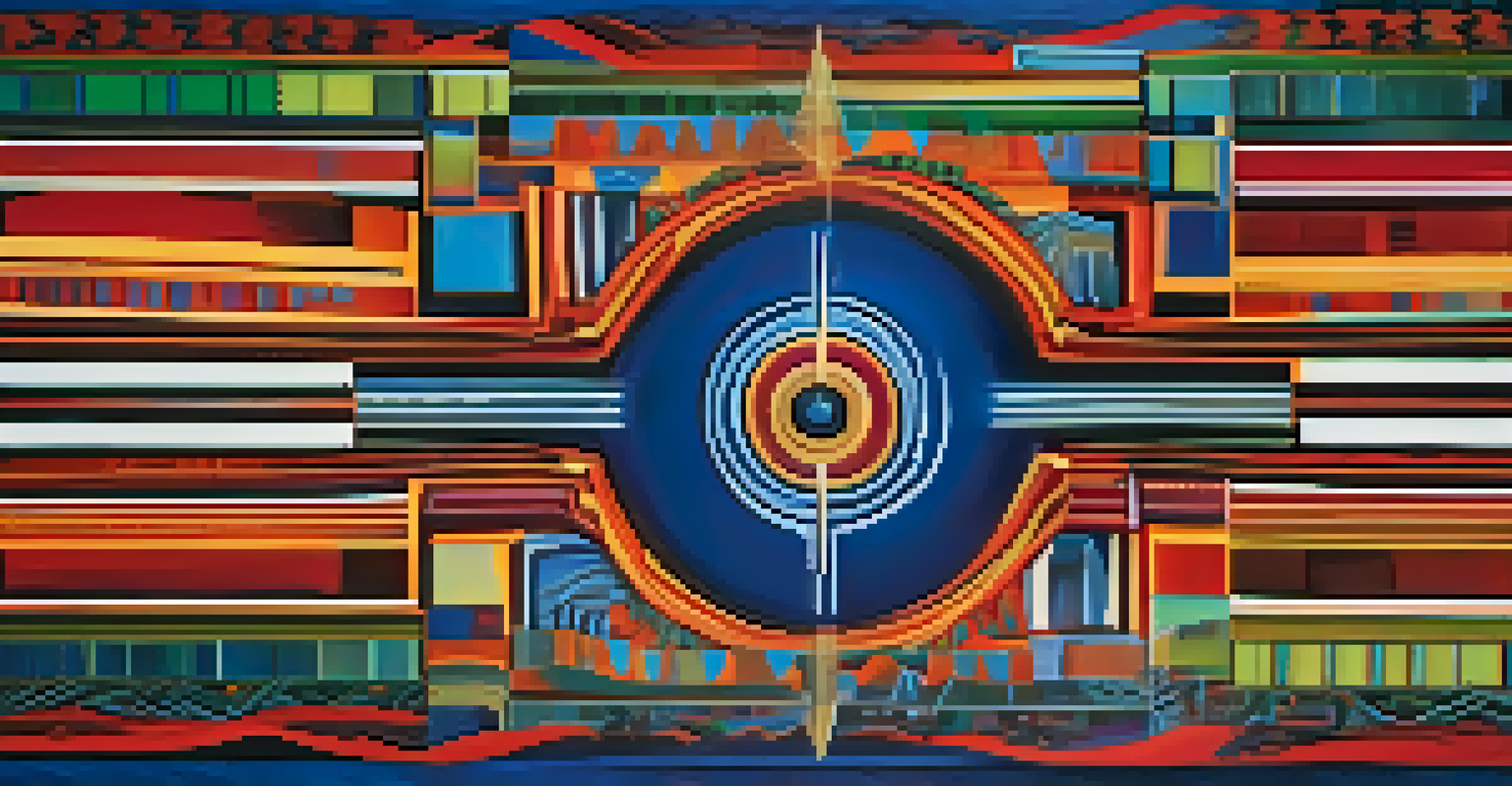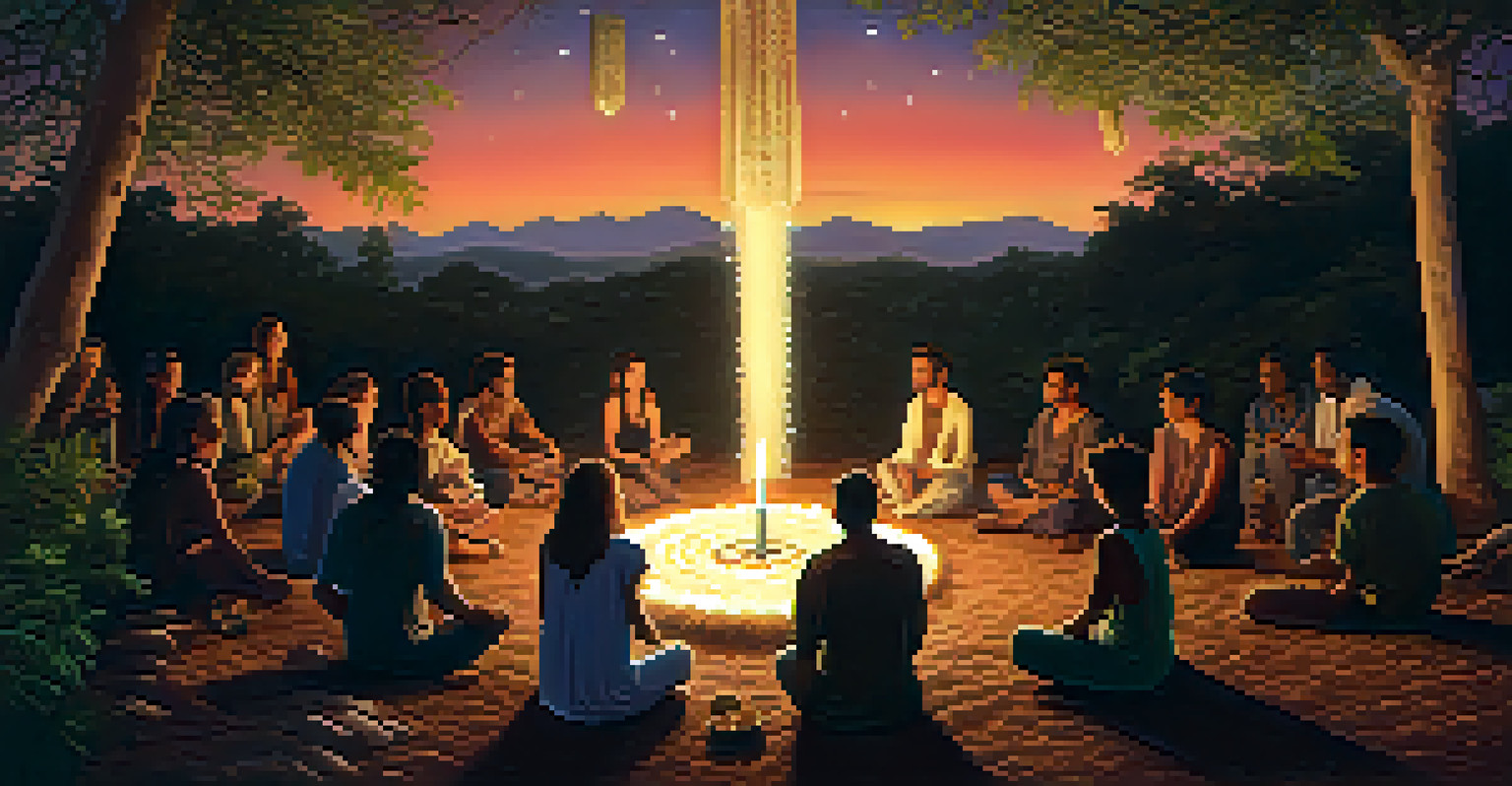The Role of Art in Depicting Ayahuasca Visual Experiences

Understanding Ayahuasca and Its Visual Journeys
Ayahuasca is a powerful plant medicine traditionally used in Amazonian shamanism. It induces profound experiences, often characterized by vivid visual hallucinations and deep psychological introspection. Participants frequently describe their journeys as connecting them to the universe, their inner selves, and the spirits of nature.
Art is a way of recognizing oneself and enriching one’s spiritual journey.
These experiences can vary significantly from person to person, creating a rich tapestry of visions that reflect individual thoughts, emotions, and cultural backgrounds. The visuals can range from geometric patterns and vibrant colors to more intricate scenes depicting personal stories or universal symbols. This diversity makes Ayahuasca a unique subject for artistic expression.
Art serves as a bridge to convey these complex and often ineffable experiences, allowing others to glimpse the surreal beauty encountered during Ayahuasca ceremonies. Artists tap into their creativity, channeling the spirit of the experience into their work, which can range from painting and sculpture to digital media and performance art.
The Intersection of Art and Spiritual Experience
Art has long been a medium for expressing spiritual and transcendent experiences. In the context of Ayahuasca, it becomes a powerful tool for artists to interpret and share the feelings and visions that arise during their journeys. This connection between art and spirituality invites viewers into a deeper understanding of the emotional and mystical aspects of Ayahuasca.

For many artists, the act of creating art post-Ayahuasca serves as a form of therapy, allowing them to process their experiences in a tangible way. By translating their visions into art, they not only document their journeys but also create a shared narrative that resonates with others who have undergone similar experiences. This sense of community can be incredibly healing.
Ayahuasca's Powerful Visual Journeys
Participants often experience vivid hallucinations and profound insights that connect them deeply to themselves and the universe.
Moreover, the act of sharing this art fosters dialogue about the broader implications of Ayahuasca use, spirituality, and personal growth. It encourages viewers to reflect on their own experiences and beliefs, creating a space for connection and understanding that transcends cultural boundaries.
Visual Symbols Commonly Found in Ayahuasca Art
Ayahuasca art is often rich with symbolism, drawing from cultural, spiritual, and personal influences. Common motifs include geometric patterns, which many describe as a visual language of the universe, and representations of animals or plants that hold significance in indigenous cultures. These symbols can evoke feelings of connection to nature and the cosmos.
Creativity takes courage.
Artists frequently incorporate vibrant colors that mirror the intensity of their experiences. For instance, deep blues and purples might represent tranquility and introspection, while fiery reds and oranges might signify passion or transformation. This use of color not only enhances the visual impact but also evokes emotional responses in the viewer.
Additionally, some artworks depict mythical beings or spiritual guides encountered during Ayahuasca journeys. These representations can serve as powerful reminders of the wisdom and insights gained during the experience, inviting viewers to explore their own interpretations and connections to the spiritual realm.
The Influence of Indigenous Cultures on Ayahuasca Art
Indigenous cultures, particularly those of the Amazon, have profoundly influenced the portrayal of Ayahuasca experiences in art. Traditional shamanic practices often include the creation of intricate visual art forms, such as textiles and pottery, which serve both aesthetic and spiritual purposes. These practices provide a foundation for contemporary artists exploring Ayahuasca themes.
Many modern artists draw inspiration from the visual styles and techniques of indigenous artisans, blending traditional elements with personal interpretations of their Ayahuasca experiences. This fusion not only honors the cultural heritage but also expands the narrative of what Ayahuasca art can be. It creates a dialogue between the past and present, enriching the artistic landscape.
Art as Healing and Expression
Artists use their Ayahuasca experiences to create art that serves as a therapeutic outlet and fosters community dialogue.
Furthermore, the incorporation of indigenous symbolism and storytelling into contemporary art helps preserve and promote awareness of these cultures. By showcasing these elements, artists contribute to a greater appreciation of the wisdom embedded in indigenous practices and beliefs, fostering respect and understanding among diverse audiences.
Art as a Tool for Healing and Integration
After an Ayahuasca experience, many individuals seek ways to integrate their insights into everyday life. Art can play a crucial role in this process, serving as a form of expression that allows individuals to articulate their feelings and thoughts. Creating or engaging with art can facilitate healing and promote a sense of closure.
For some, the act of painting, drawing, or crafting becomes a therapeutic outlet, helping them to process challenging emotions or experiences encountered during their journey. This creative expression can also foster a sense of empowerment, as individuals reclaim their narratives and share their stories through art.
Moreover, art exhibitions and community art projects centered around Ayahuasca experiences can create safe spaces for dialogue and support. These gatherings encourage people to share their stories and connect with others, reinforcing the idea that healing is often a communal journey, enriched by shared experiences and understanding.
The Role of Digital Media in Ayahuasca Art
In today's digital age, artists are increasingly utilizing technology to depict their Ayahuasca experiences. Digital art, virtual reality, and immersive installations allow for innovative expressions that can capture the essence of these journeys in new and exciting ways. This evolution expands the possibilities for how art can be experienced and shared.
Digital platforms also enable artists to reach a global audience, transcending geographical boundaries and inviting diverse interpretations of their work. Social media, in particular, has become a powerful tool for artists to share their creations, fostering connections with others who resonate with their experiences. This accessibility creates a community where shared understanding flourishes.
Indigenous Influence on Ayahuasca Art
Contemporary Ayahuasca art is enriched by traditional indigenous symbols and techniques, creating a dialogue between past and present.
Additionally, digital art can incorporate interactive elements, allowing viewers to engage in the artwork in a way that feels immersive. This interactivity mirrors the participatory nature of Ayahuasca experiences, inviting audiences to explore their own connections to the art and the themes it represents.
The Future of Ayahuasca Art and Its Impact
As interest in Ayahuasca continues to grow, so does the potential for art to play a significant role in its narrative. The future of Ayahuasca art is likely to see even more diverse interpretations as artists from various backgrounds share their unique perspectives. This evolution will enrich the conversation surrounding Ayahuasca and its cultural significance.
Moreover, as conversations about mental health and spirituality become more mainstream, art depicting Ayahuasca experiences can contribute to a broader understanding of its potential benefits and challenges. By fostering open discussions, art can help demystify Ayahuasca and encourage responsible exploration of its use.

Ultimately, the role of art in depicting Ayahuasca visual experiences is about more than aesthetics; it's about connection, healing, and the sharing of human experiences. As artists continue to explore these themes, they contribute to a rich tapestry of understanding that honors both the individual and collective journeys of those who have engaged with this profound plant medicine.